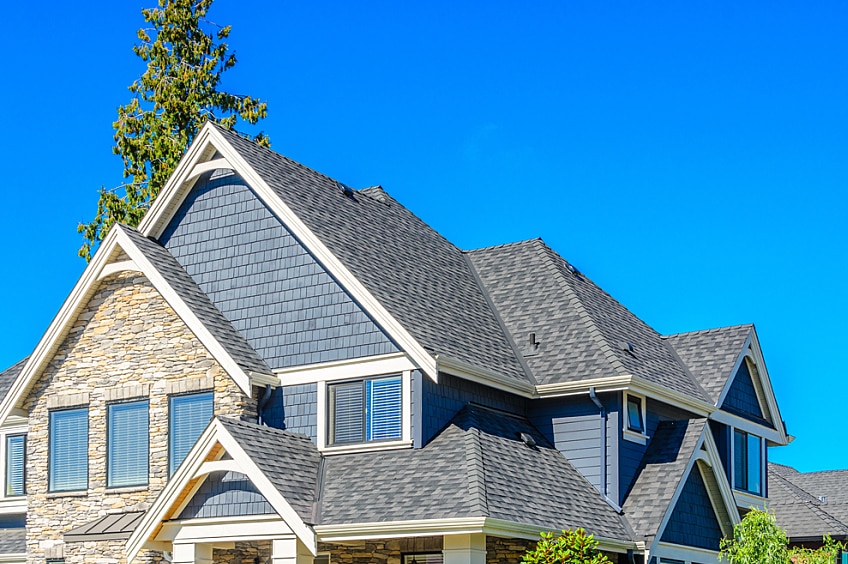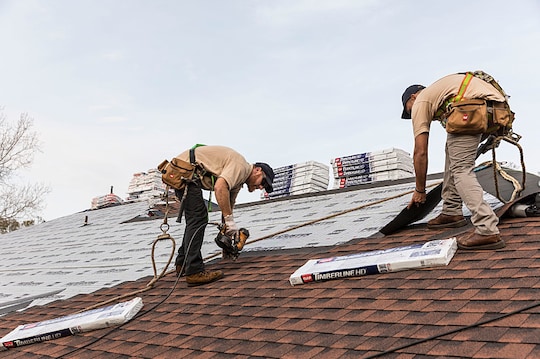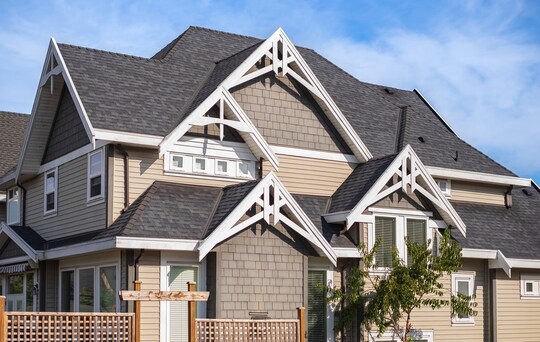
Una atractiva combinación de colores para la casa y el techo puede lograr un gran atractivo exterior. El hecho de añadir un atractivo visual hace que el lugar se sienta como propio y también aporta un mayor valor de venta. On average, homes considered to have curb appeal sell for 7% to 14% more than similar homes with less visual appeal, according to the Journal of Real Estate Finance and Economics.
The right roof shingle color improves the overall aesthetic of your home, but other factors-such as your area's climate-may also influence which shade you choose. Consider these guidelines for updating your house with a new color palette.
Match Your Home's Style
Your home's style is made up of the building design, the siding's colors and materials, your landscaping, and more. Don't let a new roof clash with your home's existing style! When installing a new roof, consider these factors to choose the right color roof shingles for your home.
Home Design
What style is your home—farmhouse, cottage, mid century modern, Victorian? Choose a roofing shingle style that complements that aesthetic. For example, wood-shake architectural shingles might look out of place on the stark clean lines of an extremely modern home. Alternately, wood-shake look architectural shingles (in a natural tone such as the Timberline® NS Weathered Wood) typically complement a craftsman-style home.
Tamaño del techo
Consider how much of your home's visual exterior is made up of the roof. Does your roof have a lot of architectural detail? Does it command a large square footage? If so, a dramatic or dark shingle color may be too visually dominant to be cohesive with your overall aesthetic. Look at your roof from the sidewalk and street, and take photos to use in the GAF Virtual Remodeler. The free online tool will give you a feel for how different shingle colors will come across with your home's other exterior features.
Paint and Trim Color
Choose shingle colors that complement the color family of your home's paint and trim. For example, color consultant Amy Wax recommends selecting brown-toned shingle colors if you have brick siding or warm house paint tones such as beige or taupe.
Conversely, choosing gray or black-toned shingles may be more visually pleasing if you have a cool paint color such as gray or cool green or blue, or cool stone siding details. Boldly blended shingle colors with both cool and warm tones offer the most versatility, as long as you match your exterior paint colors properly.
If you plan to change your paint color in the future, be sure to factor that into your decision, too!
Consider Your Surroundings
Your home is (probably) not an island. Therefore, take your regional climate and neighborhood style into account when choosing your shingle color. Here's why climate and neighborhood style are important to consider.
Daily Forecast
Your roof shingles could absorb or reflect more sun depending on shingle color and type. If your home seems to bake in the arid sun, you might want to take into consideration Timberline HDZ® RS Shingles, which are highly reflective and may help reduce cooling costs*. If you're maximizing the sun by collecting solar energy with solar shingles, such as Timberline Solar, then black shingles will help absorb that heat.
Since dark shingles absorb more heat, folks in cold climates may help offset cold climate heating costs with darker shingle colors. Dark shingles may also reduce the visibility of blue-green algae stains, if you haven't already chosen a shingle with a warranty against algae discoloration.
Happy Hood
Look around your neighborhood while selecting your new shingle color. What are the popular architectural styles in your area? Do you want to blend in or stand out? Be sure to take local building codes and requirements into account as well.
Boost Home Resale Value
Investing in a new roof may bring you a larger home sale down the line. In fact, a recent report by the National Association of Realtors found that home sellers recovered 107% of the value of new roofing remodeling projects.
Potential homebuyers will likely be turned off by damaged and stained roofs. However, even a new roof could negatively impact a homebuyer's decision if the color doesn't appeal to them. A unique color can make your roof pop, but some choices could be jarring or reduce your home's resale value. If you have a home sale in your future, consider a neutral shingle color that can complement a range of paint colors instead of a bold shingle color that you personally love but might not be for everyone.
The most economical shingle option when installing a new roof is a 3-tab shingle. That said, architectural shingles offer enhanced color and design options, as well as stronger warranties; therefore, they may be more appealing to potential buyers and offer greater returns on investment.
Follow a Shingle Shopping Checklist
Ready to get started shingle shopping? Save the shingle-buying checklist below and refer to it as you browse shingle options.
Estilo
Understand the style of your home. What are traditional color choices for your home's architecture?
Go for complementary colors. Choose home and roof colors that cooperate instead of clash. Pair cool paint with cool shingles and warm paint with warm-toned shingles.
Surroundings
Know the shingle availability in your region. Be sure shingles are available before falling in love.
Know your climate and location. Does hot, cold, or wet weather impact your color choice?
Mesh with the neighbors. Having a hard time deciding? Take local architecture and area color palettes into account.
Resale
Consider home goals. If you're planning to sell, avoid a statement roof and stay neutral.
Look at the whole house. A complementary house and roof color combination can boost your resale value.
Want to add new life to your home with an upgraded roof and shingle color? Consult with a shingle and roofing expert by connecting with a GAF Certified Contractor**.
*Energy cost savings are not guaranteed and may vary based on factors, such as climate zone, utility rates, and HVAC equipment efficiency.
**Contractors enrolled in GAF certification programs are not employees or agents of GAF, and GAF does not control or otherwise supervise these independent businesses. Los contratistas pueden recibir beneficios, como puntos y descuentos de recompensa por lealtad en herramientas de comercialización de GAF por participar en el programa y ofrecer a GAF garantías mejoradas, que requieren el uso de una cantidad mínima de productos de GAF.



